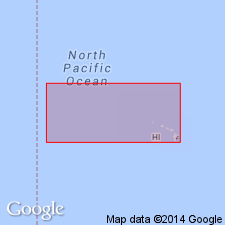
- Usage in publication:
-
- Waimea volcanic series
- Modifications:
-
- Named
- Dominant lithology:
-
- Basalt
- AAPG geologic province:
-
- Kauai
Summary:
Named for exposures in Waimea Canyon, Island of Kauai, HI. Forms main bulk of Island. Divided into extra-caldera or lower member (composed of 3500 ft of thin-bedded primitive-type olivine basalts) and caldera-filling or upper member (composed of 4000 ft of massive olivine basalts). Underlies with angular erosional unconformity Koloa volcanic series. Assigned Tertiary age.
Source: GNU records (USGS DDS-6; Menlo GNULEX).
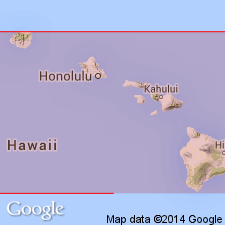
- Usage in publication:
-
- Waimea Canyon volcanic series*
- Modifications:
-
- Redescribed
- AAPG geologic province:
-
- Kauai
Summary:
Name Waimea volcanic series of Stearns (1946) replaced by Waimea Canyon volcanic series since name Waimea was preoccupied. Type locality: walls of Waimea Canyon [21 deg 58' 08"N, 159 deg 39' 28"W, Hanapepe 7.5' quad] Island of Kauai. Assigned Pliocene(?) age on figure map.
Source: GNU records (USGS DDS-6; Menlo GNULEX).
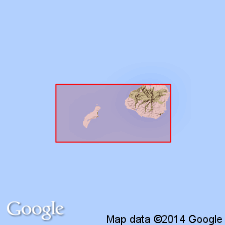
- Usage in publication:
-
- Waimea Canyon volcanic series*
- Modifications:
-
- Revised
- AAPG geologic province:
-
- Kauai
Summary:
Divided into (ascending) Napali (new), Haupu (formerly Haupu volcanic series of Stearns, 1946), Olokele (new), Makaweli (new) and Mokuone (new) formations. Mokuone sedimentary rocks are interbedded with Makaweli formation.
Source: GNU records (USGS DDS-6; Menlo GNULEX).
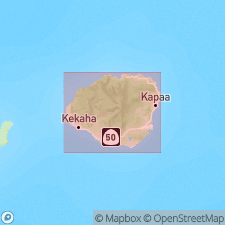
- Usage in publication:
-
- Waimea Canyon volcanic series*
- Modifications:
-
- Revised
- AAPG geologic province:
-
- Kauai
Summary:
Divided into (ascending) Napali, Olokele, Haupu, and Makaweli (including Mokuone member) formations. Type locality of series is in walls of Waimea Canyon where four of mapped formations are well exposed. The fifth, Haupu formation (formerly Haupu volcanic series of Stearns, 1946) is restricted to caldera in Haupu ridge on SE part of Island of Kauai. Underlies Quaternary sedimentary deposits along stream valleys and coast. Age on stratigraphic chart assigned Pliocene but text has probable Pliocene(?) age based on estimated rates of extrusion of volcanics to build present size of island. Age is late Tertiary on map legend
Source: GNU records (USGS DDS-6; Menlo GNULEX).
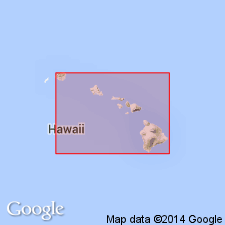
- Usage in publication:
-
- Waimea Canyon volcanic series*
- Modifications:
-
- Geochronologic dating
- AAPG geologic province:
-
- Kauai
Summary:
K-Ar ages on lava samples from Napali formation (collected on S side of shield at 250 ft elev. and high on W rim of Waimea Canyon) ranged from 5.72 to 4.44 Ma. K-Ar ages on lava samples from Makaweli formation (collected in Waimea Canyon and on Olokele ditch track) ranged from 4.05 to 3.48 Ma.
Source: GNU records (USGS DDS-6; Menlo GNULEX).
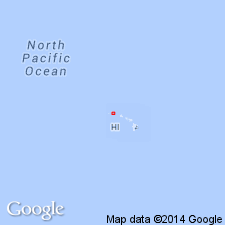
- Usage in publication:
-
- Waimea Canyon Volcanic Series*
- Modifications:
-
- Paleomagnetics
- AAPG geologic province:
-
- Kauai
Summary:
Paleomagnetic studies were made on samples from Napali Formation (5 from most flows) and Makaweli Formation (8 from each lava flow) of the Waimea Canyon Volcanic Series. "In general, the magnetic polarity results and radiometric age data obtained by McDougall (1964) are in agreement with recent summaries of the polarity epoch time scale (Cox, 1968)." Lavas of Makaweli Formation (3.9 to 3.8 Ma) are reversely magnetized and placed in late portion of Gilbert Reversed Polarity Chron.
Source: GNU records (USGS DDS-6; Menlo GNULEX).
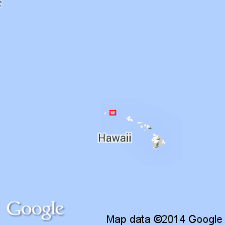
- Usage in publication:
-
- Waimea Canyon Volcanic Series*
- Modifications:
-
- Geochronologic dating
- AAPG geologic province:
-
- Kauai
Summary:
K-Ar ages on 16 samples of tholeiitic basalt from Napali Formation (collected in Waipao Valley on southern flanks of shield north of Kekaha, west coast near Polihale and near Haena adjacent to northwest coast) ranged from 5.14 +/-0.20 to 3.81 +/-0 0.06 Ma
Source: GNU records (USGS DDS-6; Menlo GNULEX).
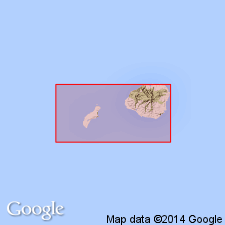
- Usage in publication:
-
- Waimea Canyon Basalt*
- Modifications:
-
- Geochronologic dating
- AAPG geologic province:
-
- Kauai
Summary:
K-Ar ages on rare postshield stage flows of hawaiite and mugearite at top of Olokele and Makaweli Members of Waimea Canyon Basalt indicate 3.95 +/-0.04 to 3.91 +/-0.04 Ma.
Source: GNU records (USGS DDS-6; Menlo GNULEX).
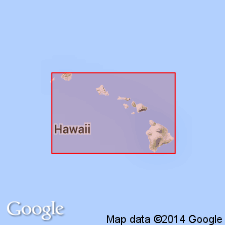
- Usage in publication:
-
- Waimea Canyon Basalt*
- Modifications:
-
- Revised
- AAPG geologic province:
-
- Kauai
Summary:
Waimea Canyon Volcanic Series (Macdonald, 1949) reduced in rank and renamed Waimea Canyon Basalt. Its subdivisions are reduced to member rank and are called Napali, Haupu, Olokele, and Makaweli Members. Unit within Makaweli is reduced in rank and renamed Mokuone Breccia Beds. Assigned Miocene(?) and Pliocene age based on interpretation of K-Ar ages.
Source: GNU records (USGS DDS-6; Menlo GNULEX).
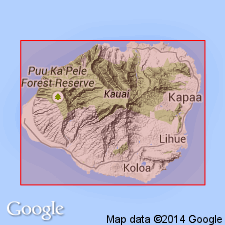
- Usage in publication:
-
- Waimea Canyon Basalt*
- Modifications:
-
- Geochronologic dating
- AAPG geologic province:
-
- Kauai
Summary:
Based on all data available, best ages for Waimea Canyon Basalt appear to be 5.1 to 4.35 Ma for Napali Member (McDougall, 1974), 4.16 to 4.00 Ma for tholeiitic flows (and coeval ages of 3.92 Ma for alkalic flows) in Makaweli Member (McDougall, 1964 and this study) and 3.95 Ma for alkalic flow at top of Olokele Member (this study).
Source: GNU records (USGS DDS-6; Menlo GNULEX).
For more information, please contact Nancy Stamm, Geologic Names Committee Secretary.
Asterisk (*) indicates published by U.S. Geological Survey authors.
"No current usage" (†) implies that a name has been abandoned or has fallen into disuse. Former usage and, if known, replacement name given in parentheses ( ).
Slash (/) indicates name conflicts with nomenclatural guidelines (CSN, 1933; ACSN, 1961, 1970; NACSN, 1983, 2005, 2021). May be explained within brackets ([ ]).

